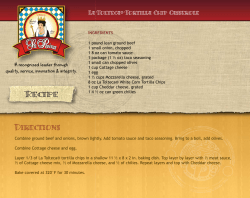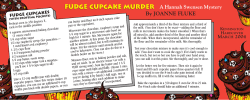
Traditional Mozzarella
Traditional Mozzarella Traditional Mozzarella di Bufala is made from Water Buffalo milk, but for most home cheesemakers, that’s a little hard to come by. Mozzarella handmade from good cow’s milk is a wonderful substitute. The natural and slow acidification produces a cheese that is far superior to its 30-Minute cousin. Ingredients ∞ ∞ ∞ ∞ ∞ ∞ ∞ ∞ 2 gallons of whole cow’s milk. Do not use ultra pasteurized or “organic”. Do not use low fat; we are going to balance that out in Step 3. 1 pint heavy cream. Do not use ultra pasteurized or “organic”. 1 cup non-fat dry (NFD) milk. This reduces the fat content and improves the protein ratios without adding additional liquid to the mix. The higher protein level gives a better curd set. 1 cup active buttermilk and 6 tablespoons of fresh yogurt. Or use 1/2 teaspoon of dry Mesophilic culture. Leuconostoc bacteria make long chains and will improve stretch. So Aroma B is a good culture choice. 1/2 teaspoon mild powdered Lipase. This is optional but gives a more traditional Italian flavor. 1/2 teaspoon of rennet dissolved in 1/4 cup cool purified water. Prepare a brine solution of 2 cups of Kosher salt in 2 quarts of water. Warm to dissolve the salt then chill. See Tricks and Tips. Directions – Part 1 1. Pour milk and cream into your pot. Add the NFD milk and the Lipase. 2. Heat to 90F in a stainless pot on your stove or on an induction cooker. If you use your stove place milk in a double boiler or stir constantly to avoid scorching. 3. Turn off heat, add buttermilk & yogurt, or dry culture. Let dry culture dehydrate for 5 minutes. Mix well. 4. Let sit for 20-30 minutes so that the bacteria can start developing acid. PH should be around 6.5. 5. We are going to use the “Flocculation method” so have a small sanitized bowl and a timer available. 6. Add rennet and stir with gentle up and down strokes for 20-30 seconds. Use the spoon to stop all milk motion. Start the timer. 7. Place the empty sanitized bowl on the milk and periodically check for surface gelling by nudging the bowl. Initially, the bowl will easily “spin”. When it no longer moves, the surface has gelled. This is called the Flocculation Point and should take 10-15 minutes. Note the time it has taken to flocculate and multiply this time by 3 (the floc multiplier for Mozzarella) to get the total time to wait to cut the curd. For example: a flocculation time of 10 minutes means that the curds will be ready to cut at 30 minutes after adding rennet. NOTE - different cheeses use different multipliers to achieve the correct moisture and texture. 8. After waiting the proper time for a 3X multiplier, cut the curds vertically and horizontally into large 2” pieces. Let rest for 10 minutes so the curds can heal. 9. Use a long handled whisk to cut curds into 1/2" pieces. The bacteria are starting to produce more acid by now and the pH should be around 6.3-6.4. 10. Slowly heat to 100F being sure that it takes 30 minutes to do so. You can easily do this by putting the pot into a sink of 115-120F water. Do not heat too quickly or the cheese will retain moisture. Gently stir constantly. Cut any large chunks into smaller uniform pieces. Do not overheat or it will change the texture. 11. Turn off the heat (or remove from sink) and let the curds settle for 15 minutes. By now the pH should have dropped to 6.0-6.1. 12. Drain the whey from the curds by pouring everything into a straining bag or cheesecloth over the colander. Save the whey if you want to make Ricotta. The pH should now be around 6.0 13. The bacteria still have a long way to go before the curds can be turned into Mozzarella. You can either wait 3-8 hours or refrigerate and continue the next morning. I do the latter. 14. The next morning, the pH should be down to around 5.3. If not, warm the curds to speed up the process. 15. The bacteria continue to produce lactic acid from lactose and you want to catch the curds at just the right acidity and pH. If there is not enough acid, the curds will break apart and not stretch. If there is too much acid the cheese makes a brittle mess and shatters. 16. You are looking for a pH of between 5.0 and 5.2. If you have a pH meter, it is easy to see when it is getting close to ready. If you do not or choose not to test for pH, then it is time to start doing stretch tests. Directions Part 2 – Stretching (and other fun stuff) 1. Test for stretch by cutting off a piece of the curd and dipping it in very hot water (at least 150eF). If it stretches, the curds are ready, it if breaks apart, leave for another 30 minutes and test again. If the curd falls apart into mush, it has over acidified. And cannot be recovered. Check every 30-60 minutes for stretch to avoid over acidifying. 2. While waiting, heat 4 quarts of water or whey to 150-170F. If using water, add a little Calcium Chloride. 3. Once the curds have reached the proper pH and stretch point cut into thin strips, about 1/2” inch wide and 1” long on a sanitized cutting board and place 1/4 of the curds in a large mixing bowl. 4. Pour enough hot water into the bowl to just cover the cut curds. 5. Wearing sanitized heat resistant rubber gloves, work the curds into one large ball, kneading and shaping it under water. This can also be done with a pair or wooden spoons, but takes a little practice. Lift from the water and stretch it into a long rope. Loop back on itself then pull again. Repeat pulling and looping until the curd is shiny and smooth. Work quickly or the curd will cool and become brittle. If this happens, simply dip the curds back into the hot water to warm and soften. 6. Shape or mold as desired. Place the cheese in the chilled brine solution for 20-30 minutes to taste. 7. Repeat for the remaining curds. 8. Mozzarella is at it’s best when used fresh. However it can be stored in the refrigerator in a closed container for up to 2 weeks. Mozzarella can also be frozen and thawed slowly in the refrigerator but this does affect the texture. If you are using it on pizza or in many recipes it will not be noticeable. Options ∞ Mozz can be rolled into a ball, worked into a rope, or even molded without pressing. For a fun, kinky “twist” try making braided Armenian String Cheese (this takes some practice). Tricks & T ips ∞ ∞ There are many European “pasta filata” cheeses that are variations on Mozzarella. You can make Mozz as an overnight recipe, but it is very important that you drain when the pH is at or below 6.2. This is usually about 1.5-2 hours from adding buttermilk and bacteria. Drain the whey, place the curd mass in the fridge and go to bed. It should be ready to stretch in the morning. Troubleshooting ∞ Curds shatter after cutting them and trying to stir the first time. The manufacturer has over processed your milk. Use different milk. Make sure milk is not ultra pasteurized. You can usually save the day making a fresh white cheese out of it. ∞ Curd does not stretch in test. Wait a little longer, not enough acid has been developed. If a piece of curd mushes and falls apart, that’s too much acid. If it stretches a little and breaks, not enough. ∞ Mozz is rubbery. Six factors need to come together for moist Mozz: correct curd size, correct multiplier and set time, fat content, low cook temp, adequate acid, and gentle handling. One or more of these is off if it is rubbery. ∞ Mozz is too soft and mushy. You waited too long to stretch, and the curd became too acidic. ∞ Cheese lacks flavor. Try another brand of milk and/or buttermilk. Use dry culture for consistent results. Try adding more lipase. ∞ Curd does not set. Check rennet age and make sure to use distilled water for diluting. Add 1/4 tsp CaCl2 solution/gal in the future for the milk or use different milk. Directions Part 2 (Alternative) – Using A Microwave 1. Cut off a piece of the curd for stretch testing. Put the piece you cut off in the microwave for 10-30 seconds (depends on microwave power). Pull on one end. Does it stretch? If it does, you're ready to move forward. If not, flip the ball of curd and check back again in a half hour, then cut off another piece and nuke it. Keep waiting and checking every half hour until the curd stretches when you microwave it. You could check less often, but until you're comfortable, check more frequently so you get it to work the first time and build up your confidence. 2. When the bit of curd does stretch, take the bowl with the curd in it cut up the curd into 1" chunks, and put it in the microwave. Start with 1 minute and try to fold the curd chunks together with a spatula. It should be hot and it should start to come together and be stretchy. Check the temp. Ideal temp is about 150F, or higher, up to 170. Keep folding the curd, and if necessary, heat in microwave again. In general, follow the stretching instructions in the previous Part 2 section. Stretch with your hands if you want. Keep pulling and stretching until the curd is shiny and smooth. 3. After you have the Mozz ball made, combine 8 cups of the whey with 2 cups of salt and mix. It's okay if not all of it dissolves. Use less whey and salt if you want. Add some ice cubes to the brine. Plop the ball of cheese in it and wait for 5-10 minutes, depending on how salty you want it. And you're done, wrap in something and refrigerate.
© Copyright 2025















